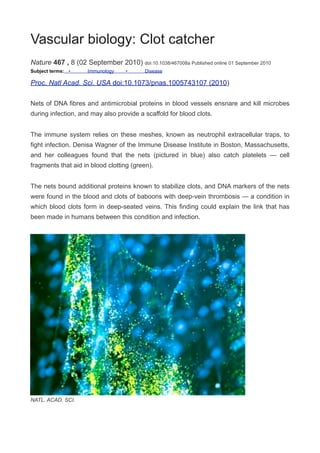Report
Share
Download to read offline

Recommended
Recommended
Cell free culture supernatant of bifidobacterium breve cncm i-4035 decreases ...

Cell free culture supernatant of bifidobacterium breve cncm i-4035 decreases ...Alfonso Enrique Islas Rodríguez
9 esculentin 1–21 a linear antimicrobial peptide from frog skin with inhibit...

9 esculentin 1–21 a linear antimicrobial peptide from frog skin with inhibit...Alfonso Enrique Islas Rodríguez
5 antimicrobial and antistaphylococcal biofilm activity from the sea urchin p...

5 antimicrobial and antistaphylococcal biofilm activity from the sea urchin p...Alfonso Enrique Islas Rodríguez
Propuesta de creación del laboratorio de estudio de sustancias naturales d...

Propuesta de creación del laboratorio de estudio de sustancias naturales d...Alfonso Enrique Islas Rodríguez
Propuesta de creación del laboratorio de estudio de sustancias naturales d...

Propuesta de creación del laboratorio de estudio de sustancias naturales d...Alfonso Enrique Islas Rodríguez
More Related Content
More from Alfonso Enrique Islas Rodríguez
Cell free culture supernatant of bifidobacterium breve cncm i-4035 decreases ...

Cell free culture supernatant of bifidobacterium breve cncm i-4035 decreases ...Alfonso Enrique Islas Rodríguez
9 esculentin 1–21 a linear antimicrobial peptide from frog skin with inhibit...

9 esculentin 1–21 a linear antimicrobial peptide from frog skin with inhibit...Alfonso Enrique Islas Rodríguez
5 antimicrobial and antistaphylococcal biofilm activity from the sea urchin p...

5 antimicrobial and antistaphylococcal biofilm activity from the sea urchin p...Alfonso Enrique Islas Rodríguez
Propuesta de creación del laboratorio de estudio de sustancias naturales d...

Propuesta de creación del laboratorio de estudio de sustancias naturales d...Alfonso Enrique Islas Rodríguez
Propuesta de creación del laboratorio de estudio de sustancias naturales d...

Propuesta de creación del laboratorio de estudio de sustancias naturales d...Alfonso Enrique Islas Rodríguez
More from Alfonso Enrique Islas Rodríguez (20)
Cell free culture supernatant of bifidobacterium breve cncm i-4035 decreases ...

Cell free culture supernatant of bifidobacterium breve cncm i-4035 decreases ...
The gut microbiota — masters of host development and physiology

The gut microbiota — masters of host development and physiology
9 esculentin 1–21 a linear antimicrobial peptide from frog skin with inhibit...

9 esculentin 1–21 a linear antimicrobial peptide from frog skin with inhibit...
6 antibacterial activity in four marine crustacean decapods copia

6 antibacterial activity in four marine crustacean decapods copia
5 antimicrobial and antistaphylococcal biofilm activity from the sea urchin p...

5 antimicrobial and antistaphylococcal biofilm activity from the sea urchin p...
Propuesta de creación del laboratorio de estudio de sustancias naturales d...

Propuesta de creación del laboratorio de estudio de sustancias naturales d...
Propuesta de creación del laboratorio de estudio de sustancias naturales d...

Propuesta de creación del laboratorio de estudio de sustancias naturales d...
Body’s hardworking microbes get some overdue respect

Body’s hardworking microbes get some overdue respect
Nets
- 1. Vascular biology: Clot catcher Nature 467 , 8 (02 September 2010) doi:10.1038/467008a Published online 01 September 2010 Subject terms: • Immunology • Disease Proc. Natl Acad. Sci. USA doi:10.1073/pnas.1005743107 (2010) Nets of DNA fibres and antimicrobial proteins in blood vessels ensnare and kill microbes during infection, and may also provide a scaffold for blood clots. The immune system relies on these meshes, known as neutrophil extracellular traps, to fight infection. Denisa Wagner of the Immune Disease Institute in Boston, Massachusetts, and her colleagues found that the nets (pictured in blue) also catch platelets — cell fragments that aid in blood clotting (green). The nets bound additional proteins known to stabilize clots, and DNA markers of the nets were found in the blood and clots of baboons with deep-vein thrombosis — a condition in which blood clots form in deep-seated veins. This finding could explain the link that has been made in humans between this condition and infection. NATL. ACAD. SCI.
